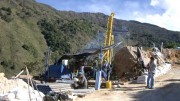Sensible valuation of mineral properties has become more critical through the current low phase of the market cycle. Valuation of mineral properties at the exploration stage is an area where both valuators and users of valuations need to understand the challenges and uncertainties involved. Sorting the wheat from the chaff can be challenging for non-technical readers of such valuation reports. However, these readers can look for certain aspects in the reports to satisfy themselves as to the quality of the work and the confidence they can have in the assigned values.
The valuator, as defined in the CIMVal Standards and Guidelines for Valuation of Mineral Properties (which can be found at www.cim.org, and are being updated) must have the appropriate qualifications and exploration experience relevant to the property being valued, so that the requirements of the relevant national reporting standard (e.g., CIMVal standards and guidelines in Canada, the VALMIN code in Australia and the SAMVAL code in South Africa) can be satisfied. His or her certificate, attesting to these qualifications and experience, should be included in the report. Except in limited circumstances, which must be explained, the valuator should be independent and undertake a site visit to the property.
Values should be derived using more than one valuation method whenever possible. The method applied depends on the nature of the valuation, the development status of the mineral property, and the extent and reliability of available information.
There are three generally accepted valuation approaches in the mining industry: income approach, which is based on expected benefits, usually in the form of discounted cash flow; cost approach, based on the principle of contribution to value through past exploration expenditures; and market approach, based on actual or comparable transactions.
Income approaches are applied to later-stage mineral resource/reserve and development properties (and are therefore not discussed further in this article), with cost or market approaches for exploration and early stage mineral resource properties. Any resources or reserves relied upon should comply with, or be reconciled with, the relevant national reporting standard, in Canada’s case, with the CIM Definition Standards on Mineral Resources and Reserves, which are referenced by National Instrument 43-101.
With respect to the cost approach, there are different philosophies on the use of expenditure that is planned or committed, but not spent at the time of the valuation. One view (to which the author subscribes) is such that planned expenditures should not be included, while another view is that it is reasonable to include warranted future costs.
Appendix 3G: Valuation Standards and Guidelines for Mineral Properties of the TSX Venture Exchange Disclosure Obligations for Mining Companies states that “the exchange does not generally accept the inclusion of warranted future expenditures for the purposes of the appraised value method.”
Whichever approach is adopted, the report must make it clear whether, and to what extent, future costs have contributed to the valuation.
One of the main market approaches is comparable transactions (sometimes known as the “real estate” method). This method can provide very useful data on which to base a valuation if a reasonable number of truly comparable transactions can be found.
Unfortunately, this is often not the case, and professional judgments have to be made on the basis of a few (if any) truly comparable transactions, and a larger number of only partly comparable transactions. If a reasonable database of values can be compiled, then derivative methods such as value-per-unit area of the property, value per unit of contained metal in mineral resources or mineral reserves can be applied.
Market valuation approaches may involve analyzing the terms of an exploration option or joint-venture agreement in order to convert them into the equivalent of a cash transaction at the time of the deal. This is based on the rationale that, in being prepared to incur expenditure to earn an interest in (or farm-in to) an exploration property, the purchaser is placing a monetary value on the vendor’s interest at the time that the deal is made. That value is referred to as the “deemed expenditure” and it usually represents the full value of the property at the time of the deal.
There are generally four components to a joint venture or farm-in agreement:
Cash — This is usually relatively easy to convert to present value. However, if the transaction involves time payment deals or payments dependent on future events, such as a decision to mine, the relevant cash amounts need to be discounted for time and probability of the future event occurring.
Shares — These should be converted to cash using the share price at the time of the deal and treated like cash payments for future amounts. Conversion can be more complex if the shares are in an unlisted company.
Exploration expenditures — Annual exploration commitments are usually part of option/farm-in/joint-venture agreements, with those after the first year optional along with the cash and share commitments. These also need to be discounted for time and for the probability that they will be incurred.
Conditional payments — For example, royalties, feasibility study, sole funding, etc. These require adjustment for time, the probability of the project going ahead and, in the case of royalties, the likely parameters on which the royalty could be based. The author’s experience is that the influence of conditional payments on value is usually small because of time/probability discounts, and because such payments are generally only a small part of the deal.
Given the subjectivity of the valuation methods used for exploration properties, it is not usually sensible to produce values more detailed than the nearest $100,000 for significant projects, or than the nearest $10,000 for lesser projects. The final valuation is an experience-based judgment based on weighting of the individual values. It should always be expressed as a range in order to reflect the uncertainty and subjectivity of the exercise.
Valuators must ensure that they exercise their independence and do not succumb to client pressure to produce a desired result. The client often has a vested interest in whether a valuation is on the high side, as, for example, in a takeover defence, or the low side, as, for example, in an assessment of tax liability. Valuators must remain true to their professional obligations and ethics, and resist any such pressure.
The valuation report should be clear, transparent and logically presented, and explain why and by whom the valuation was requested. It should explain why certain methods were used and others were not, and any limitations on their applicability. It must contain all the material information necessary to allow both experts and non-experts to understand how the valuation was derived, including a description of the key risks, assumptions, limitations and uncertainties. It should compare the result with previous valuations of the property.
Finally and most importantly, the valuation must be consistent with values likely to be assigned in real life. A key test is: Would you pay $X for the property if it was your money?
— Pat R. Stephenson, P.Geo., is a director and principal geologist at AMC Mining Consultants (Canada) Ltd. in Vancouver. He specializes in mineral resource and reserve auditing and reporting, due diligence reviews, independent technic
al reports, expert witness activities and mineral asset valuations.
AMC Consultants is a leading independent mining consultancy providing services exclusively to the minerals sector. It has offices in Canada (Vancouver and Toronto), Australia, the U.K. and Singapore. AMC works with clients to plan new mines or improve the operations of existing mines, with a focus on achieving optimum output and return. Please visit www.amcconsultants.com.au for more information.




Be the first to comment on "Commentary: What’s the best way to value mineral exploration properties?"